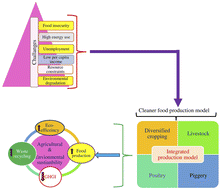Designing an energy efficient, economically feasible, and environmentally robust integrated farming system model for sustainable food production in the Indian Himalayas†
Abstract
Globally, the agricultural production system is threatened by the adversities of climate change, land degradation, low energy productivity, and poor environmental outcomes. Thus, there is a dire need to design and develop sustainable agricultural food production technologies that can potentially ensure household-level food security with a minimum environmental footprint. Achieving a balance in the food-energy trade-off while conserving the ecosystem base and minimizing greenhouse gas (GHG) emissions for achieving sustainable environmental livelihoods is a pressing challenge in the Indian Himalayas. Therefore, it was hypothesized that the integrated farming model involving organic cultivation practices shall reduce farmland waste, and arrest land degradation while sustaining higher productivity, energy use efficiency, and profitability. Thus, the productivity, profitability, energy security, and environmental sustainability of four integrated organic farming system (IOFS) models (viz., PS-I, mono-cropping + livestock; PS-II, diversified cropping + livestock; PS-III, diversified cropping + livestock + poultry, and PS-IV, diversified cropping + livestock + poultry + piggery) were assessed during 2016–19 in the Meghalaya region of the Indian Himalayas. All the designed integrated farming/production systems had higher energy profitability and eco-efficiency and substantially reduced greenhouse gas intensity (GHGI) compared to PS-I. PS-IV recorded a significantly higher net economic return (US$ 2828.5 per y), energy productivity (0.22 kg MJ−1), and eco-efficiency (0.31 US$ per kg CO2eq), and the lowest GHGI (0.33 kg CO2eq per kg food production) compared to other production systems. GHG (per kg production) emissions of PS-IV were also 1.7 times lower than those of PS-I. Furthermore, PS-IV had recycled 81.1, 68.2, and 68.8% higher N, P, and K than the usual business (PS-1), respectively. Thus, the study suggested that PS-IV could be a profitable, energy-efficient, environmentally friendly, and economically viable sustainable production system. Hence, PS-IV can be recommended as an economically feasible and environmentally robust production model for ensuring household-level livelihood security in the Indian Himalayas.



 Please wait while we load your content...
Please wait while we load your content...